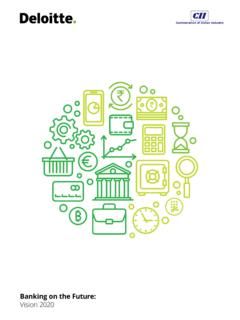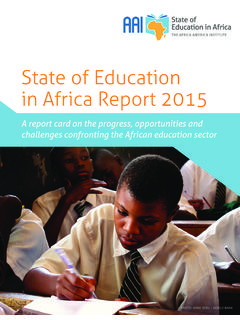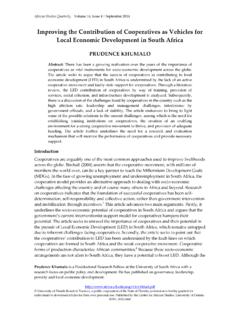Transcription of Deloitte on Africa The Rise and Rise of the African …
1 Deloitte on AfricaThe Rise and Rise of the African middle ClassThe rise of the middle class , as a percentage of the population, has been steady - in 1980, 111 million or 26% of the continent s population fell in this category rising to million or 27% of the population in 1990 with a further surge to 196 million in 2000 and a dramatic increase to 313 million in 2010 equating to of the population ( African Development Bank, 2011). In contrast, the rise in absolute numbers, compared to the percentage rise, has been more dramatic and this is best explained by the increase in population with Africa having hit the 1 billion population mark in 2010.
2 This population boom captures, at once, the African opportunity and her dilemma. The opportunity is that large population numbers create the very necessary volume for any consumer goods and services. Numbers move product. The dilemma is that Africa s population growth has undercut any dramatic reduction in poverty. For now though, we will focus only on the opportunity on the premise that profit is underpinned by is vital, at this early juncture, to define the term middle class . The African Development Bank (AfDB) defines the African middle class as those spending between US$2 and US$20 a day.
3 While, in the developed world, this may appear too low to be classified as middle class spending, the Bank deems this range appropriate given the cost of living on the world s poorest continent. middle class is defined in relation to the average income and that average is lower in Africa than in the west. They take a PPP perspective not Private Public Partnership rather, Purchasing Power Parity perspective. Simply put, US$20 has more stretch in Benin, for instance, than in the USA. Within this broad African middle class category, there are further sub-classes: upper middle class equates to those spending between US$10 and US$20 a day.
4 Lower middle refers to those spending US$4 and US$10 a day and the floating class are those that are the most vulnerable in society spending between US$2 and US$4 this only slight above the developing world poverty line of US$2 person per day. At 313 million, the African middle class is roughly the same size as its Indian and Chinese counterparts and this is the very basis of media reports such as Africa is the new Asia - Newsweek cover in 2010 and the The Hopeful Continent: Africa Rising with the subtext: After decades of slow growth, Africa has a real chance to follow in the footsteps of Asia (The Economist, 2011) Africa s middle class has tripled over the last 30 years, with one in three people now considered to be living above the poverty line - but not among the wealthy.
5 The current trajectory suggests that the African middle class will grow to billion (42%) in 2060. As African economies are growing (7 of the 10 fastest growing in the world are African ), the wealth is trickling down and Africa now has the fastest growing middle class in the Deloitte on Africa Collection: Issue 1 The urban/rural divide in Africa is pervasive of all socio-economic aspects and, evidently, that divide also features heavily in the definition of who is middle class in Africa . What they are generally not: They do not derive income from farming and rural economic activities.
6 What they generally are: They live in urban centres. In terms of residence, middle class households tend to reside in bigger and more permanent dwellings equipped with modern amenities. Higher levels of tertiary education. Hold salaried jobs. Are small business owners. Young and in the acquisitive phase of life. Have fewer children than previous generations and certainly than those in the rural areas. Have strong vested interest in their children s welfare. They tend to opt for private education and health services. Send their children to overseas universities.
7 May receive remittances from relatives living in the Diaspora. Total Diaspora remittances are estimated at US$ 38 billion. terms of asset ownership, the middle class is typically associated with the widespread ownership of major household durable goods such as refrigerators, telephones, flat screen TVs and automobiles. They have more recreational time. They are harnessing technology. Political assertive. Culturally African middle class : Who are they? Deloitte on Africa Collection: Issue 1 3 The African middle class : Where are they?Distribution of middle Classes in Total Populations in African Countries in 2010 African countries with a, relatively, lower concentration of middle class among their population compared to the category above.
8 21-50% of the population in this category can be classified as middle class this including the floating class . It is worth noting that there is a significant gap between countries in this category compared to those in the category above. In this category, Botswana is at the upper limit with 48% of it s population classified as middle class . Gabon is at the lower limit of the next category with 75% of it s population classified as middle class followed Algeria 77%, Egypt 80%, Morocco 85%, and Tunisia 90%.MOROCCOALGERIATUNISIAEGYPTLIBYANIGER IAMAURITANIACAPE VERDE ISLANDSMALISENEGALGUINEALIBERIABURKINA FASONIGERCHADSUDANCENTRAL African REPUBLICETHIOPIAERITREADJIBOUTICAMEROONI VORYCOASTBENINGABONDEMOCRATICREPUBLIC OF CONGOANGOLANAMIBIASOUTH AFRICABOTSWANAZAMBIAKENYATANZANIAUGANDAR WANDABURUNDIMOZAMBIQUEMALAWIMADAGASCARA frican countries with, relatively, the lowest concentration of middle class among their population.
9 In these countries, the middle class , including the floating class , constitutes up to 20% of the total countries with highest concentration of the middle class among their population. However, a significant number of this middle class belong to the floating category, living on less than $4 per day with the ever present danger of falling into poverty in the event of exogenous economic shocks. In the context of this definition, whereby middle class includes those in the floating class , at least 75% of the population are classified middle : African Development Bank; Deloitte analysisGAMBIAGUINEA-BISSAUSIERRA LEONEWESTERN SAHARATOGOEQUATORIAL GUINEACONGO BRAZAVILLECABINDACOMORESZIMBABWEMAURITIU SREUNIONSEYCHELLESLESOTHOSWAZILANDGHANA4 Deloitte on Africa Collection: Issue 1 How does the rise of the middle class manifest?
10 In a globalised world, Africa is not impervious to new trends and influences that are fast shaping consumer behaviours and consumption patterns. Africans are also aspirational. African consumers want the same as consumers elsewhere a mobile phone, a bank account, and the latest Beyonce CD bought in a store at a shopping mall. And indeed, shopping malls are sprouting in the continent s major capitals - Dakar, Lagos, Accra, Nairobi and Lusaka. In Deloitte s interactions with various clients expanding on the continent, it is clear that there is a need for formal retail infrastructure.



















